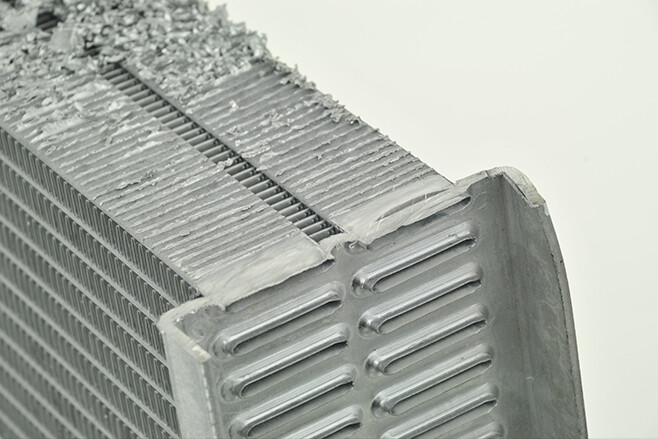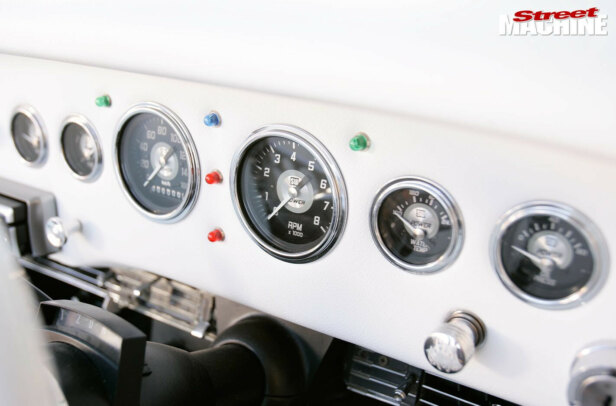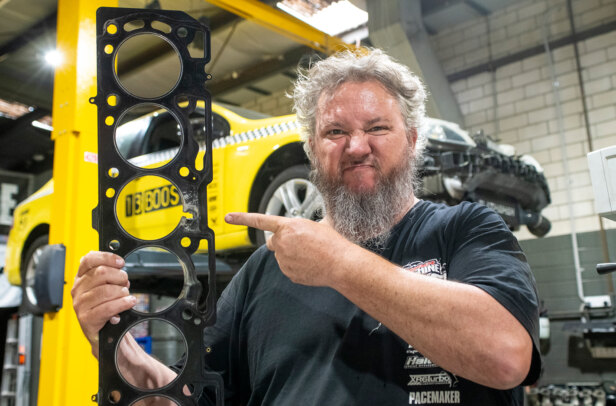With tuned engines making crazy power, what prevents them overheating?
POWER creates heat, so keeping hot streeters cool has been an issue pretty much since Karl Benz whipped the covers off his Motorwagen in 1885. However, while power output figures are growing faster than the national debt, overheating isn’t anywhere near the problem it was. Why is that? Talking to a few cooling experts it appears there are three major factors: more efficient radiators, electric coolant pumps and better coolant additives.
RADIATOR EFFICIENCY
Two of the main components of a radiator are the tubes through which coolant flows and the fins set between them. As coolant passes through the tubes, heat is transferred into the fins and then into the air flowing over the fins.
The tubes in early radiators were round, which is a bad shape because for a given cross-sectional area, round tubes have minimal surface area — the opposite of what’s needed. Also, airflow past a round tube is very poor. Using a flatter tube reduces cross-sectional area, while simultaneously increasing surface area. This exposes more coolant to more surface area as well as improving airflow past the tube, a win-win scenario.
 Heat transfer from the tube to the fin takes place where they join so increasing the surface area of a tube relative to the cross-sectional area also increases the contact area with the fins, resulting in further improvements to heat transfer. Refinement of the tube/fin matrix is one of the fundamental reasons modern radiators can cope with high power levels.
Heat transfer from the tube to the fin takes place where they join so increasing the surface area of a tube relative to the cross-sectional area also increases the contact area with the fins, resulting in further improvements to heat transfer. Refinement of the tube/fin matrix is one of the fundamental reasons modern radiators can cope with high power levels.
Tank baffling can enhance efficiency by up to 15 per cent. The baffles divide the radiator into three separate segments, forcing the coolant to flow sequentially from one section into the next. This design is known as a triple-bypass system.
 Factory radiators have crimped-on plastic end-tanks. These are fine for standard applications but welded endtanks result in the far greater strength needed for highoutput engines
Factory radiators have crimped-on plastic end-tanks. These are fine for standard applications but welded endtanks result in the far greater strength needed for highoutput engines
MAKE IT BETTER
A Radiator is all about exposing coolant to air. More tubes means more coolant. However, lots of tubes separated by small gaps impede air flow. Conversely, fewer tubes with bigger gaps increase airflow but reduce coolant capacity.
One solution is to add extra layers of tubes, making the whole radiator thicker. Each layer of tubes is known as a core. You would have heard the terms dual-core and triple-core; these are sometimes also referred to as two or three-row radiators. The more cores, the greater the cooling capacity but there is a limit. After four cores it becomes difficult for air to pass through a radiator, reducing efficiency.
The same goes for fins; more fins shed more heat but too many fins will hinder airflow and reduce cooling effectiveness.
Optimising the balance between the thickness of the radiator and the transverse spacing of tubes and fins has been integral to improving cooling system performance. Manufacturers use windtunnel testing to balance these various elements.
COPPER/BRASS
Copper is an excellent conductor of heat so it’s an ideal material for fins. However, the pressure commonly found in a cooling system calls for stronger tubes. Brass is stronger and still conducts well, making it the material of choice for tubes, header/end tanks and fittings. Despite the superior conductivity of copper and brass, radiators manufactured from these materials are heavy. For this reason, OEM and aftermarket parts now use aluminium to combat the weight issue.
ALUMINIUM
Aluminium may not conduct quite as well as copper but it’s not far off. More importantly, aluminium is stronger than copper or brass. This makes a huge difference to the performance of a radiator as it allows for wider tubes that further increase the contact area with the fins and thus improve heat transfer.
As an example, an optimally arranged four-core copper/brass assembly from Aussie Desert Cooler (ADC) has a 67mm-thick core. Because of their greater strength, thin-walled aluminium tubes can be up to 42mm wide and still retain sufficient strength to withstand the high pressures of modern performance cooling systems. One 42mm layer of tubes makes for a much thinner and lighter core that allows greater airflow and better cooling.
For even greater capacity, two layers of 25mm aluminium tubes can be combined to make a core that’s still only 57mm thick. Overall, aluminium radiators are much more efficient, which is why they can effectively cool such high-powered engines.
FANS
Airflow is as important as radiator efficiency, which brings us to fans. At high vehicle speeds, natural airflow through the radiator will usually keep temperatures under control. Engine-driven fans pull most air at higher engine and vehicle speeds and least at idle or low vehicle speed — the opposite of what’s required. Electric fans are a big improvement as they create airflow as it’s needed.
Most radiators are rectangular in shape, so a fan can’t pull air through the entire fin area; it’s just not the right shape.
A shroud that encompasses the entire fin area at the rear of the radiator and draws it into the face of the fan is essential. According to Norm at ADC, the diameter of the rear of the shroud should be about an inch bigger than the tips of the fan blades. When viewed from the side, the fan blades should be half in and half out of the rear edge of the shroud for maximum efficiency.
Sometimes there just isn’t the space for a really big fan combined with a shroud so two fans have to be used — again with an appropriate shroud. Note that two fans that are each half the diameter of one large fan will give you only half the cross-sectional area of the larger unit, so a big single unit is best if you can fit it in.
Norm also points out that an average V8 streeter needs about 2000cfm for cooling and that some fans are simply incapable of moving this volume of air. Find out the cfm ratings of any fan(s) you intend to use and make sure your installation can meet or exceed 2000cfm.
MODIFICATION
Traditionally, replacement radiators were seen as having to fit in the space the factory allowed. This is still often the case, with most aftermarket manufacturers optimising their designs to work within the original dimensions.
However, as custom cars become increasingly radical, more builders are happy to modify their vehicles to accept wider or taller radiators that significantly increase cooling capacity. Increasing surface area by going wider and taller also allows a thinner core to be used without reducing capacity, which can help with space issues.
PUMPS
As with fans, engine-driven coolant pumps are less than ideal for actual operating conditions. Transferring the job of coolant circulation to an electrically driven pump makes the process of matching coolant flow to actual engine requirements much more feasible.
Some pumps are designed to completely replace the original mechanical pump, some are designed to supplement them, while other models (like those from Davies, Craig) can assume both roles.
Any electric pump can be connected to run continuously or in conjunction with a thermatic switch. For a daily driver, be wary of pumps not designed for continuous use — some are designed for short use only, such as for racing.
The greatest benefit of an electric pump is gained when it’s connected to a digital controller such as the Davies, Craig 8020.
Norm at ADC explains that if coolant is circulated too quickly, it doesn’t spend enough time in the radiator for it to dissipate the heat. The 8020 solves this problem by varying the flow rate as well as activating the fans at a user-selectable temperature. After shutdown, the 8020 continues running the pump and fans until a pre-set temperature is reached, eliminating the potential for destructive heat soak.
BURNOUT CARS
High-powered streeters need the best cooling systems possible but burnout cars have very special requirements due to the punishing conditions under which they compete. They operate at high revs for up to three minutes under considerable load yet with extremely limited forward motion. In addition, the air available for cooling is usually hot and full of smoke, and if all that isn’t enough, they go from full noise to switched off instantly.
The resultant heat soak can be disastrous and hoses often blow, which can cause serious damage. So the best radiator combined with electrically controlled fans and coolant pumps that continue operating after the engine is turned off are mandatory for managing the temperatures in any car destined for the burnout pad.
COOLANT
You’ll note the term ‘coolant’ used rather than ‘water’ — no car should ever have plain water in its cooling system. Older readers may remember the days when service station attendants would top up your water while filling your tank. That water came straight from the tap, which allowed scale and rust to build up inside the coolant circuit and act as an insulator, inhibiting the effectiveness of the system.
Modern alloy engine specifications have made glycol-based coolants, or anti-freeze, mandatory. Even though cooling systems almost never freeze in Australia, glycol also acts to raise the boiling point of plain water by a couple of degrees depending on the concentration of the mix.
The important thing to remember is that coolants are carefully formulated, so mixing different types together will lead to unpredictable results, even if they’re both quality brands. This means that flushing your system is mandatory when doing your annual coolant change or when changing brands.
 To flush, drain the system, including the heater core and overflow recovery bottle, and rinse through with clean water. Making sure you’ve cleaned the system thoroughly will require several fill/drain operations or continuous flushing. After this, fill the system with a good alkaline flushing solution. Run the engine at normal operating temperature for 15 to 30 minutes with the heater turned on to ensure the whole system is thoroughly flushed out. Then fill with a quality coolant mixed to the proper concentration.
To flush, drain the system, including the heater core and overflow recovery bottle, and rinse through with clean water. Making sure you’ve cleaned the system thoroughly will require several fill/drain operations or continuous flushing. After this, fill the system with a good alkaline flushing solution. Run the engine at normal operating temperature for 15 to 30 minutes with the heater turned on to ensure the whole system is thoroughly flushed out. Then fill with a quality coolant mixed to the proper concentration.
With a large, efficient radiator, effective fans, an electric pump and quality coolant, overheating issues will no longer be the bane of your existence.




Comments